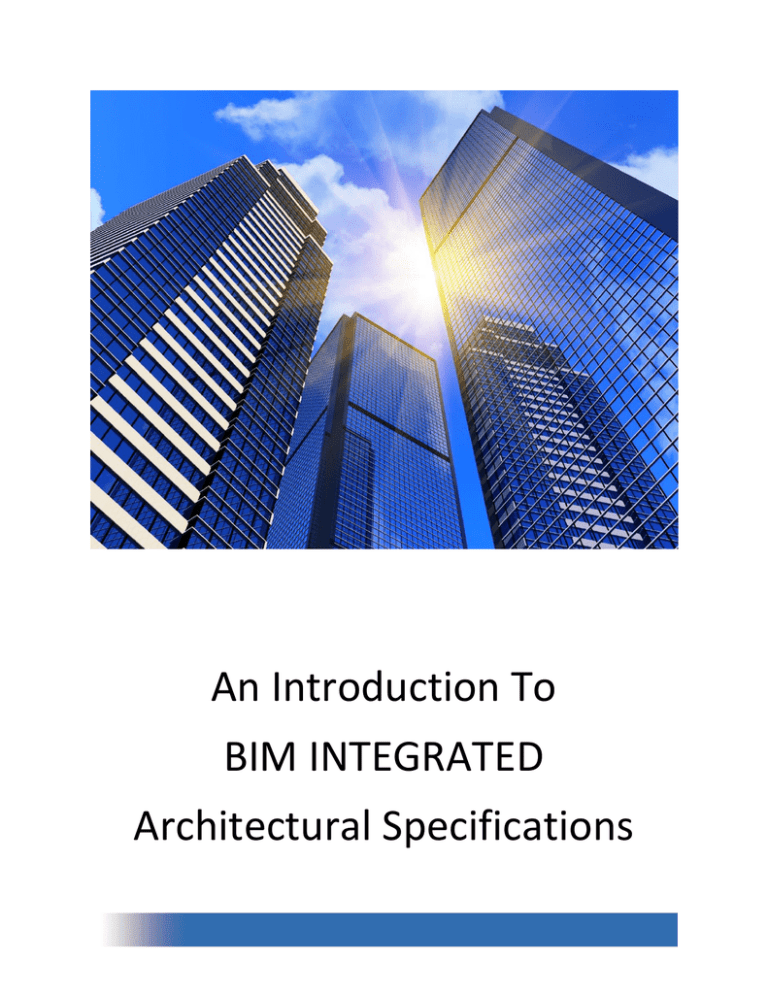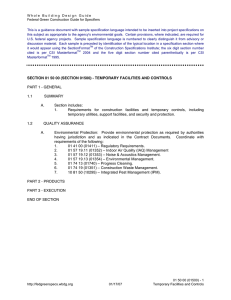An Introduction To BIM INTEGRATED Architectural - e
advertisement

An Introduction To BIM INTEGRATED Architectural Specifications WHAT ARE SPECIFICATIONS? Specifications are documents that accompany and govern the construction of a building. The guiding library of master specifications, from which the project manual will be created, is organized in MasterFormat. MasterFormat was developed and is jointly sponsored by the Construction Specifications Canada and the Construction Specifications Institute. The specifications fall into 50 Divisions, or broad categories of work involved in construction. The Divisions are organized into Sections, each one addressing a narrower scope of construction work. Each Section is subdivided into three distinct Parts: “General”, “Products” and “Execution”. The MasterFormat system can be successfully applied to residential, commercial, civil and industrial construction. The project manual is then a complete legal document that defines the execution of all project requirements, materials, equipment, systems, standards and required workmanship as detailed below. WHEN ARE SPECIFICATIONS DEVELOPED? In early phases of a project – called the conceptual or schematic design phase – the specifications are comprised of a skeleton list of materials or systems that form the basis of the design. During the design development (DD) phase, specifications form an outline spec. the outline spec can be as brief or as detailed as the project, design and client demand. During the construction documents (CD) phase, the specifications contain multi-page spec sections for each group of materials. The specs must contain all details governing the quality of materials and workmanship required in the finished project. HOW ARE SPECIFICATIONS DEVELOPED? Starting from scratch Creating every project specification from scratch would clearly be cumbersome, unnecessary and expensive. However, this approach still applies when specifying a new or unusual product, system or process. Adjusting an old project manual Adapting a specification from a previous project is an approach commonly employed by designers. However, this won’t provide the updated options, materials or codes required for the new project. According to industry experts, this approach is inherently flawed and should be avoided. Using an office master Most medium-size and larger design practices maintain some form of office master. This generally takes the shape of a catalog of standard sections – based on corporate design preferences and lessons learned. Using a master specification library A master specification library is the industry standard for maintaining quality. By accessing a wider range of industry expertise, a master specification library offers accurate updates to codes, materials and workmanship that reflect industry thinking. A master specification library allows spec writers to concentrate on the core task of precisely reflecting and recording project requirements. The most popular master specification libraries include AIA MasterSpec libraries, Canadian masters (CMS and NMS), the U.S. Dept. of Veteran Affairs (VA) master and the DOD’s United Facilities Guide Specifications (UFGS) master, among others. METHODS OF SPECIFYING The Subtractive Method This method allows the spec writer to delete what doesn’t apply, using a standard workflow. Generally, projects will also require the addition of project-specific information, making the subtractive method impractical. The Additive Method This method allows the spec writer to select from a standard spec library, adding projectspecific language as necessary. The additive approach allows the spec writer to mix and match from a full database of spec content to accurately reflect a specific project. This produces a truly customized specification. The e-SPECS Method e-SPECS is a master specification management system that builds upon the additive method by applying checklist technology to the firm’s chosen master specification libraries. The specifier selects only the spec sections needed from the checklist to build the project manual. While working within each section, the spec writer saves time with the e-SPECS Editor functionality: double click to include or exclude text, insert merge fields for full customization and more. No information is ever deleted, so text can be changed as the project evolves. Combining its patented checklist and editor technology, e-SPECS enhances the spec writer’s ability to produce a wholly customized project manual, while saving them 75% time over other workflows. WHAT ARE BIM INTEGRATED SPECS? e-specs Revit leads the BIM revolution with solutions for integrated design, engineering and fabrication workflows. BIM integrated specifications are specifications automated from the building drawings and models. BIM integrated specs offer the most coordinated, complete project specification manual. They reduce time and effort, eliminate change orders and ensure the smoothest construction process. Less time spent manually comparing the drawings and specs means more time for design. THE PURPOSE OF SPECIFICATIONS 1. A design record 6. A contract document 2. A record of decisions made 7. A project management aid 3. A record of statutory compliance 8. An on-site manual for construction 4. A cost planning tool 9. As evidence in disputes 5. A tendering document 10. A resource for facilities management & building maintenance THE e-SPECS BASICS Now in its ninth major release, e-SPECS is the first application to successfully integrate the construction drawings and specification documents, beginning with a fairly simple interface to AutoCAD over 10 years ago, along with a version for Revit after its acquisition by Autodesk. Based on continuous customer feedback and feature requests, e-SPECS is a stable, easy to implement, integrated solution that delivers real value to customers. Automation of your project Manual Let’s start with a very basic overview of how e-SPECS works in order to clarify some common misconceptions and define important terminology: e-SPECS does not magically create specification information using some super sophisticated algorithm based on items it might find in a building model. It is much simpler than that. e-SPECS creates and automates project specific specification documents by filtering preconfigured master specification documents to the requirement of the building project based on information it extracts from the Revit models. This is not unlike what most architects, engineers and specifiers do routinely to create the project specification “by hand” with word processing systems. Starting with a set of master specification documents, they review the project drawings to determine what spec sections are required, and proceed to markup the master specifications library of documents to fit the project specific requirements. HOW DOES IT WORK? e-SPECS simply automates this process. In doing so, e-SPECS provides the added benefit of ensuring that the models (and resulting drawings) and the project specifications remain in sync. At the core of the e-SPECS integration technology is a patented process to simplify the filtering of the specification master documents based on selections in a master checklist. The figure below is a diagram that illustrates relationships known as “mappings”. If the wood window tag is selected or “checked”, the relevant wood window section is selected from the master specification documents and the required paragraphs in the section is automatically included in the resulting specification documents. All the other paragraphs that are not related to the wood window are removed. To see how this actually looks in practice, the Figure below is an illustration of the e-SPECS specification checklist. If we select double hung wood windows from the checklist options… The wood window section will be inserted into the specification manual with the relevant language included and the non-required language removed, as illustrated by the Figure below. One of the principal components of the e-SPECS system is the scope and integrity of the specification master database. e-SPECS is fully integrated with: AIA MasterSpec® libraries U.S. Department of Veterans Affairs (VA) master DOD and NASA’s Unified Facilities Guide Specifications (UFGS) master Canadian master guide specifications (CMS and NMS) In addition, e-SPECS is fully configurable so you can easily customize the checklist and master documents around your company’s particular requirements – adding new sections or integrating your own custom office masters as you desire. BIM INTEGRATED ARCHITECTURAL SPECIFICATIONS Taking automation, a step further, instead of having to make the selections “manually” by checking the checkboxes in the e-SPECS checklist, users can realize fully integrated architectural specifications by associating those checkboxes to Revit elements (or assemblies) in the Revit model. When those elements are used in a particular project model, the related specification section is added automatically to the project manual. The diagram below is a graphical representation of this process. The whole process is quite simple: the elements in the model are associated to specific checklist tags to automatically “check the boxes” when the item is included in the model. This process of association between an element in the model and the e-SPECS tags is called a “binding”. e-SPECS provides a simple process to manage these associations with the e-SPECS “Binding Manager”, which is pictured below. In the Binding Manager you will notice that we have the same simple checklist as before, only now the checkbox items are “bound” to information accessible in the Revit model. In Revit, the primary integration component is the Assembly Code parameter in the Revit Family Type Properties, as the example below shows. The Revit Assembly codes are defined by the familiar UniFormat classification system. For those less familiar with it, UniFormat is an industry standard classification system, developed in part by the Construction Specifications Institute (CSI), used primarily as a way of categorizing information about building elements which may contain multiple detailed parts. As defined by the CSI, “UniFormat is a method of arranging construction information based on functional elements, or parts of a facility characterized by their functions, and often referred to as systems or assemblies. It is a way to organize information about an entire assembly with multiple detail components.” UniFormat provides a consistent way to classify building model components, regardless of the complexities of the assemblies or model elements that they represent. In the wood window example, the entire assembly could consist of a number of component parts, such as the wood frame, glazing, joint sealants, insulation, hardware and so on. In another, an assembly could consist of one simple component, and electrical junction box or a ceiling tile, for instance. THE WAY OF THE FUTURE To bridge the gap between model and specs, e-SPECS has been patently designed to adhere to industry standards and conventions where applicable. It has been designed to adhere to the conventions of UniFormat when it comes to the model components and to MasterFormat with regards to the specifications. Through its specification management system, e-SPECS provides a unique and rather simple solution to the reconciliation of these two industry standard classifications systems resulting in an automated, integrated project manual. LEARN MORE ABOUT e-SPECS Call us at (207)772-6135 Visit www.e-SPECS.com


